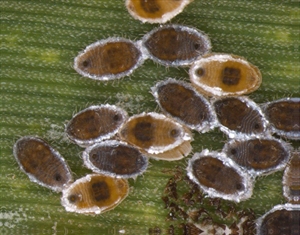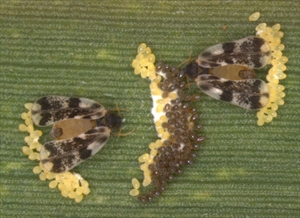Sugarcane whitefly
Pacific Pests, Pathogens, Weeds & Pesticides - Online edition
Pacific Pests, Pathogens, Weeds & Pesticides
Sugarcane whitefly (245)
Neomaskellia bergii
Asia, Africa, Oceania. It has been recorded from Fiji, French Polynesia, Federated States of Micronesia, Guam, Niue, Northern Mariana Islands, Palau, Papua New Guinea, Samoa, Solomon Islands, Tonga, and Vanuatu. It is present in New Caledonia on maize.
Sugarcane, bamboo, and several sorghum and grass species.
The nymphs are brown and oval (Photo 1), and the adults have black bands on the wings, and are arrow-shaped when at rest (Photo 2). The eggs (Photo 3), nymphs and adults are found on the underside of the leaves, often in large numbers. Ants are often found in association with the whitefly colonies (Photo 4); they come in search of honeydew.
The whitefly is a minor pest of sugarcane.
Look for the arrow-shaped adults, often with ants in attendance.
NATURAL ENEMIES
Several tiny wasp parasites, Encarsia and Eretmocerus species, as well as ladybird beetle predators attack the whitefly.
Because of the presence of natural enemies, it is very unlikely that the whitefly will need to be managed in any other way.
Note that ants may need to be removed if the natural enemies are to be effective in controlling whitefly populations. The presence of parasitoids should be checked. Look to see if the papae have holes in them, a sign that parasitoids are present. In this case, avoid the use of insecticides, unless the infestation continues to spread.
CHEMICAL CONTROL
It is unlikely that chemical control will be needed against the sugarcane whitefly.
- However, if necessary, use horticultural oil (made from petroleum), white oil (made from vegetable oils), or soap solution (see Fact Sheet no. 56).
- White oil:
- 3 tablespoons (1/3 cup) cooking oil in 4 litres water
- ½ teaspoon pure hand soap, not detergent
- Shake well and use.
- Soap:
-
Use soap (pure soap, not detergent):
- 5 tablespoons of soap in 4 litres water.
-
- White oil:
- Commercial horticultural oil can also be used. White oil, soap and horticultural oil sprays work by blocking the breathing holes of insects causing suffocation and death. Spray the undersides of leaves; the oils must contact the insects. A second application of soap or oils may be necessary after 3-4 weeks.
- Use synthetic pyrethroid insecticides to kill ants if they are present, attracted to the honeydew.
--------------------
Note, derris (Derris species) contains rotenone, an insecticide, often used as a fish poison; it should be used with caution. The commercial derris insecticide is made from Derris elliptica.
____________________
When using a pesticide (or biopesticide), always wear protective clothing and follow the instructions on the product label, such as dosage, timing of application, and pre-harvest interval. Recommendations will vary with the crop and system of cultivation. Expert advice on the most appropriate pesticide to use should always be sought from local agricultural authorities.
AUTHOR Grahame Jackson
Information from Evans GA (2007) The whiteflies (Hemiptera: Aleyrodidae) of the world and the host plants and natural enemies USDA/APHIS. Version 070606. Photos 1-3 National Bureau of Agricultural Insect Resources, ICAR, India.
Produced with support from the Australian Centre for International Agricultural Research under project PC/2010/090: Strengthening integrated crop management research in the Pacific Islands in support of sustainable intensification of high-value crop production, implemented by the University of Queensland and the Secretariat of the Pacific Community.







